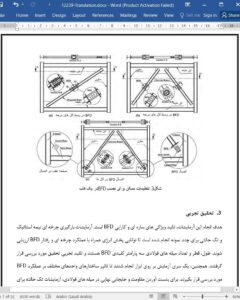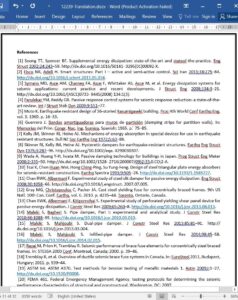Abstract
In this paper, a new passive earthquake damper termed as Bar-Fuse Damper (BFD) is presented for frame structures. The BFD is developed from common steel sections such as hot-rolled Square Hollow Sections (SHS), C-channels, plates and bars. It is economical, easy to install and build with no special fabrication technique. The key feature of the BFD is using round steel bars as energy absorber components that can be easily replaced in case of failure. The proposed device dissipates the energy with the replaceable bars as sacrificial elements through the flexural and tensile mechanism. The performance of several full-scale BFDs was evaluated with a series of monotonic and cyclic experiments, and the bars successfully performed their function as energy absorbers and fuses in all specimens. The effects of variations in the number, length and diameter of bars in the BFD along with the nuts arrangement were investigated in this experimental study. This study indicates that the recommended device has stable hysteretic behaviour under cyclic loads with two significant features: appropriate energy dissipation and replaceability of the fuses, which can be useful to protect the main elements of structures from plastic deformation and failure for several events. The results obtained for the BFD are promising for its use as a passive seismic damper in engineering structures in order to improve the seismic behaviour of structures as well as dissipating the earthquake energy.
1. Introduction
Generally speaking, structural control can be categorized as active, semi-active and passive control [1]. In active and semi-active control systems, the structural response varies based on the characteristics of the forces applied to the structure by an earthquake or wind. In other words, the structural response to the applied forces is adjusted by a control system to sustain the input loads. These control systems may consist of a power supply, sensors and hydraulic jacks [2]. On the other hand, the passive structural control is independent of the forces applied by an earthquake or wind and only depends on the type of equipment and material that were used in the damper. The main goal of the passive control systems is to reduce the contribution of the principal structural elements in dissipating the input energy by plastic deformation. Base isolators, metallic yielding dampers, friction dampers, viscous and viscoelastic dampers, tuned mass and liquid dampers are all classified as passive control systems [3,4].
7. Summery and conclusions
In this paper a new passive earthquake damper, the Bar-Fuse Damper (BFD), was presented and evaluated both experimentally and numerically. The performance of the BFD was assessed with more than 30 monotonic and cyclic experiments, and the applied bars successfully performed their function as energy absorbers and fuses in all the specimens. The proposed device showed appropriate ductility, energy absorption and stable hysteretic behaviour under cyclic loads without any sudden strength and stiffness degradation. The performance of the BFD depends highly on the nut arrangements of the bars. The simplest design, two nuts on the both ends of the threaded bar, gave a reliable behaviour to the proposed device, as well as the possibility of convenient placing and replacing the bars when they were failed. This proper replacement capability can be considered as a key feature of the proposed device over to other available metallic dampers.











